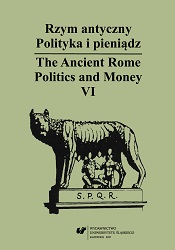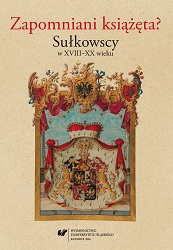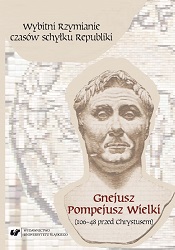Author(s): Renata Ciołek / Language(s): Polish
Publication Year: 0
The aim of the following paper is to present the circulation of money in the legionary camp on the lower Danube together with an analysis of the extent to which coins contribute to the time dating of structures in which they were unearthed. An attempt was made at reconstruction of the monetary circulation in the camps along the Danube River, based on the material accessible to the author. It comprises coins from excavations conducted by Ośrodek Badań nad Antykiem Europy Południowo-Wschodniej of Warsaw University (OBA) at the site of a military camp in Novae in the province of Moesia Inferior (Bulgaria). Studies conducted by OBA encompassed the so-called Section IV. Therefore, the coins considered in the following analyses come from the excavations of this very site. Other legionary camps on the lower Danube have been archeologically studied only partially; excavations were conducted on irregular basis, and they are not continued. Generally,the state of research into the circulation of Roman coins in Moesia is still fragmentary. Whereas there is literature on the circulation of coins during the 1st and 2nd centuries, and attempts have been made at a synthesis, the 3rd and 4th centuries are barely known. Studies in Novae have been conducted for over 50 years by Bulgarian and Polish research centers.Warsaw University has participated in these studies since the beginning. The followinganalyses have been based on excavations, archival materials and the author’s own research. Inorder to show the possibilities of time dating based on coins, several structures from excavations of Section IV have been analyzed in this paper. The site of the legionary camp in Novae, comprising the so-called Section IV, perfectly illustrates its rich history. Structures uncovered during excavations belong to different periods, staring from the time of the stationing of Legio VIII Augusta until the Middle Ages. They include: baths, a military hospital — valetudinarium and civil architecture. The pool of coins in the finds at the site of Section IV seems to be representative. During excavations of this site, 765 items in total, coming from the 1st century AD until the 7th century AD, were registered. This numberwould be at least tripled if the rest of the area were unearthed. The most plentiful group consists of the 4th century coins and the least numerous - of the 2nd and the 6th century coins. The most numerous group of the 4th century issues constitutes nearly half of all the finds.The history of the legionary camp in Novae begins in the middle of the 1st century AD, whenLegio VIII Augusta was assigned there after the end of the campaign in Britannia in AD 45. The mark of the legion’s presence is the relatively many coins of Claudius I. It can be explained by the fact that in AD 45, Novae became a part of the Roman Empire. Legion VIII was assigned to this location; a camp had to be built. A large amount of money was sent from Rome to Novae for this purpose. It is reflected in the pool of coins found in Novae in Section IV. A great majority of coins from the discussed period are connected with the existence of the large sized thermae legionis, which were built during the rule of Emperor Vespasian. The remnants of the baths, which were in operation when the Italian Legion stationed there, are very scarce. Their walls were subsequently used to built a hospital. Among other things, the pavement of the baths floor bearing the stamp of the legion has been preserved. 38 coins are connected with the Flavian baths. There is a group of coins issued before AD 97. The context of this find is unknown, but one cannot exclude their connection with the baths. The period of the functioning of the baths encompasses the Flavian Dynasty’s rule. The fact that the period before the construction of the baths was uneventful at the site of Section IV is confirmed by the absence of any Republican coins in the finds. Coins from this period were in circulationunder Julius-Claudius Dynasty relatively often. Demolition of the baths must have been carried out at the beginning of Trajan’s rule at the latest, as indicated by the group of coins found in demolition layers. The exact numismatic dating of this fact is not possible due to the fact that the youngest coin from this complex is too degraded. Moreover, the date of its issue does not coincide with the exact date of the closure of the legion baths. However, no Hadrian’s coins, or any later coins, were unearthed in the context of the baths. From the point of view of numismatics, the most probable date of the demolition of the baths is around AD 98, or shortly after. The most important object revealed in excavations of Section IV is valetudinarium, i.e., a military hospital. Its construction was begun at the beginning of Trajan’s rule. As was mentioned before, coins indicate that the baths were rebuilt into a hospital in the first years of Trajan’s rule. This dating is additionally supported by historic events, including first of all, Romans’ preparations for the Dacian Wars. It is worth mentioning a structure within the hospital, where the coin was discovered, namely an asklepeion — a healing temple, situated in the center of the courtyard. When analyzing the obtained timelines, one has to bear in mind that coins had a different time of circulation in different parts of the Roman Empire. We still have less specific data for the provinces on the Danube. The finds of coins from the period of the functioning of valetudinarium indicate that the hospital cannot have been abandoned earlier than the rule of Alexander Severus. To be dated, coins from the functional layers had to be separated from the coins from the rubblelayers, where they settled after the structure was abandoned. Their occurence in the rubble layer is meaningful for establishing the chronology of valetudinarium. It is worth recalling that the group of finds during excavations of the hospital site indicates that the object was functioning as early as during Alexander Severus’ reign. Establishing the exact year of its abandonement is not possible yet. This is not contradictory to the facts established upon the examination of other finds — primarily, Maximinus Thrax’s head and a fragment of a marble stone bearing the name of the Legio I Italica with Maximinus’ nickname, which indicatesthe passing of demantio memoriae of the legion after the emperor’s death. This would imply that the valetudinarium was abandoned in 238.In the pool of coins from excavations of Section IV in Novae, the provincial issues characteristic of Moesia and Thracia, stand out. In the earliest history of the legionary camp in Novae, “bronzes” from the central mint in Rome prevail among the denominations. Starting from the reign of Commodus, the statistics begin to change in favor of the provincials, which become the most numerous denominations, practically until the end of Gordian III’s reign. One of the first provincial coins is a beautiful, magnificent “bronze” from the Perinthus mint, struck during the reign of Commodus; no coins from the Rome mint were found. They are accompanied by scarce denarii. Such a structure of coins is typical of the monetary circulation of both Moesia and Thracia in the first half of the 3rd century.The pool of coins found in excavations of Section IV in Novae indicates the characteristics of the circulation of coins solely in the discussed province.Moesian and Thracian mints began to operate as early as in the 2nd century. The height oftheir functioning falls, however, on the first half of the 3rd century, which is very apparent in the pool of coins unearthed in Section IV of the camp in Novae. The largest supplier of provincial “bronze” coins to Novae was, as seen from the pool, the Nikopolis ad Sistrum mint, situated nearest the camp. It was the source of nearly half of the assigned provincial “bronze” coins. Compared with other mints, Marcianopolis coins constitute a relatively large group. Issues from other mints are known only as one or two specimens. The predominance of coins struck in Nicopolis ad Istrum, and secondly, in Marcianopolis is natural because both mints were closest to Novae, especially the first one. What is more, the Nicopolis ad Istrum mint was very active during its short period of operation and put a great number of coins “into circulation”. It reached its pinnacle during the rule of the Severan Dynasty, and the largest quantities of coins reached Novae during Septimus Severus’ reign. It can be explained by the fact that during his reign, the demand for a “bronze” coin was not met by the mint of Rome. Therefore, provincial mints had to increase coinage. The Marcianopolis mint was in operation a little longer. A lot of coins were also issued by the Hadrianopolis mint, yet, these were not revealed in Section IV in substantial quantities. The youngest provincial coins revealed in Novae come from the Viminacium mint, which began to operate after the decline of Thracian and remaining Moesian mints. The number of Viminacium mint coins in Section IV is rather symbolic. The functioning of mints was very sensitive to political events taking place on the territory of Moesia. The stay of Emperor Elagabalus in Moesia in 218 was distinguished in Section IV by a relatively larger presence of provincial bronzes from the two most important mints for this region, namely Nicopolis ad Istrum and Marcianopolis. An increased influx of provincial coins occured during the reign of Gordian III, as is noticeable in the pool of coins from Section IV. This can be explained with troops marching south through the Balkans in 241. This period also saw the decline of at least the majority of Moesian and Thracian mints, which is also ascribed to political events, but mostly, to the specificity of the monetary system in the second half of the 3rd century. It was at that time that a rapid and decisive deterioration of a silver coin, the Antoninianus, ensued, and the minting of “bronze” coins ceased to be economically viable. Therefore, the finds of coins from the second half of the 3rd century from this region comprise exclusively the heavily debased Antoniniani. The finds of coins from the first half of the 3rd century indicate that the demand for money in Novae within this time frame was being met only by the nearby Moesian and Thracian mints. However, one has to remember that the pool of coins at our disposal is but a small part of the “living culture” and we can count on larger quantities of coins from local mints. It is almost certain that issues from Nicopolis ad Istrum, and secondly, from Marcianopolis prevailed during this period. Thus, it is an indication that also Roman soldiers were then paid in “bronze” provincial currency, all the more so because it was a period of intensified military action, and hence increased demand for money, while the treasury was short of silver. This was reflected in the larger quantity of Septimus Severus’ coins. The emperor had to fight a fierce battle for the throne with four claimants and owed his victory to fifteen legions, including Legio I Italica.The state of research into the circulation of Roman coins during the 3rd and 4th centuriesin Moesia is still much less complete than during the preceding period. It is demonstrateded, for instance, by the hoard discovered in Novae in the ruins of the military headquaters (principia) near the chapel of banners. The coins which were successfully assigned were dated to the 4th century; the majority came from the Balkan mints. Many of those were rare specimens and some were unknown. This would point to two facts. The manufacture of these mints constituted the main body of coins that were in circulation during the late 3rd and early 4th centuries in Moesia and Thracia. This should be expected because the supplies from local mints have substantially increased after Diocletian’s monetary reform in 294. Moreover, many types of 3rd and 4th century coins are unknowkn. It shows the incompletness of our knowledge concerning the issues of coins from the Balkan mints, and also the state of research into the 3rd and 4th centuries in the discussed region. The period of Gordian III’s reign, to the beginning of Gallien’s reign, is poorly represented in the pool of coins in Section IV. It was a period of barbarians’ attacks, including the Goths who besieged the camp in Novae in 250. 4th century coins are relatively numerous here. However, the fact that 4th century coins are generally most frequently encountered throughout Europe ought to be considered. The coins from Novae were mainly minted in the Balkan Siscia, Heraclea, Ticinum, but also in Nicomedia, Thessaloniki or Cyzicus, Sirmium and Constantinople.Thus, these results are in accordance with the remarks related to the above mentioned hoard from the Western treasury in the military headquaters . It seems justified to assume, based on the pool of coins from the legionary camp in Novae, that at the turn of 3rd and 4th centuries, and, at least in the early 4th century, issues from the Balkan and Asia Minor mints prevailed, whereas issues from Western mints were in circulation there in very small quantities.Coins found in various structures within legionary camps do not offer us many possibilitiesfor time dating. These chances increase if we have the exact data concerning the archeologicalcontext of the discovered coins and can situate them in the functional layers of a given structure, and correlate them with the specimens from demolition or rubble layers. Such actions yielded expected results in the case of the military hospital due to the fact that the coins allowed to determine the time when the hospital was certainly still in use, and the time when it was certainly abandoned. The finds of coins, however, did not contribute any new data, or any further conclusions about the timeline concerning legion baths and the temple of healing deities. They only gave us terminus post quem, which is not a relevant hint in these cases. Thus, coins help in time dating, provided that a structure was functioning for a longer period of time, and that we have exact data and detailed archeological documentation. However, the monetary system of the Roman Empire, the length and the specificity of circulation of particular denomination, depending on a particular province, should be kept in mind. To sum up the information on the circulation of coins in the legionary camp, it should be emphasized that primarily, the pool of coins mirrors the camp’s history. The relatively large number of coins of Julio-Claudian Dynasty points to the beginnigs of the camp. In its earliest history, the most numerous denomination is the “bronzes” from the Rome mint, predominantly the asses, followed by the sestertii and the duspondii. From the reign of Commodus, statistics begin to change in favor of provincial coins which rise to the status of prevalent denominations practically until the end of the reign of Gordian III. Coins from the central mint were actually not found then. The characteristic feature of circulation of coins in Novae is issues of provincial mints. The finds of coins from the first half of the 3rd century indicate that the demand for money in Novae in that period of time was met solely by the nearby Moesian and Thracian mints. Denarii are rare, which demonstrates that they were not the denomination mainly used within the camp. No gold coins were found at all. Such a structure of coins is typical of the monetary circulation in both Moesia and Thracia until the first half of the 3rd century. Coins from the 4th century occur in Section IV in relatively large quantities. “Bronzes” discovered in Novae were mainly issued at the Balkan mints, including Siscia, Heraclea, Ticinum, but also Nicomedia, Thessaloniki or Cyzicus, Sirmium and Constantinople. Based on the pool of coins in the legionary camp in Novae, it is justified to conclude that at the end of the 3rd and in the 4th century, or, at least in early 4th century, issues from the Baltic and Asia Minor mints prevailed; on the other hand, issues from Western mints found their way to Novae in very small quantities.The present state of research lets us assume that the observations made about the circulationof Roman coins in Novae, based on the pool of coins from Section IV, also pertain to otherlegionary camps and smaller military structures along the lower Danube River.
More...




